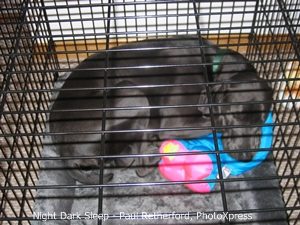Step 1: Introduce the Potty Spot
Once you have picked an elimination zone for your pet, it’s time to make some formal introductions.
- When you arrive home with your new dog, put on his leash and collar and take him to the designated “potty” spot. This sets the dog up for success immediately by giving him a chance to eliminate in the correct place.
- It is best to carry a new puppy the spot, if possible. Many puppies have never been on a leash, and you do not want the first experience with such an important training aid to be a negative one. Carrying the dog also alleviates the problem of your puppy stopping on the way out the door to go potty.
- If your dog weighs more than you do then just lead them out to the potty spot using a happy voice and cookies if necessary.
IMPORTANT NOTE: If your new dog has not had puppy shots and at least two boosters do not take him to an area where other dogs play or potty. This could be detrimental to his health. Puppies have little protection against many diseases until at least a week after their second booster.
Step 2: Add a Few Commands
Choose a single a word that will mean “Go potty”. The obvious choice here is “potty”, but feel free to get creative or use an alternative word. You’ll also use the command “Outside”.
When it’s time to go:
- Walk to the door and say, “Outside!”.
- Lead the dog to your potty spot, and say “Potty!”
- Place your dog on the ground, and hold the leash loosely.
Dogs learn by repetition so if you repeat it every time you take them out they will add a new human word to their vocabulary.
Step 3: Let’s go Potty
About now, you and your dog are milling about the potty area. It’s time for a little patience!
- Stand with a relaxed posture and tell the dog to “Go Potty.” Your dog may not show a lot of interest in transacting business at first – everything in a puppy’s world is distracting. This is where patience comes in. It does not matter if they roll in the grass, try to chase a butterfly or bark at your foot. Ignore everything except the behavior that you want – completing business.
- Do not stare at, walk around with, speak to or play with your dog. This time is used to let him think about what you want him to do.
- Glance at your dog occasionally and say, “Go Potty“ in a happy yet calm voice. Do not use an excited let’s play voice or a “GO-POTTY-before-I-strangle-you” tone. Neither will help your puppy focus on the task at hand.
- After your dog starts to potty, wait for him to just about finish. Praise enthusiastically. “Woohoo, Good Potty!” Praise and treat your dog for doing the right thing. Be very careful with timing your praise! Your dog might stop in the middle of business and you will be stuck outside waiting for act two. Worse yet, you will go inside thinking that potty training is completed, and you will have an indoor accident.
- Remember that just because your dog urinated, the job is not complete. Give your dog a little more time to finish. Dogs will not need to poop every time that they urinate so watch for signs that they still need a bit more time to finish their business.
Step 4: Learn the Signals
In an earlier section, we listed the “tail tail” signs that your dog needs to take care of a little business. These included sniffing around, loitering by the door, barking, and other attention getters. Usually, the more set the potty training behavior, the more overt the dog’s signal, but early in the training process you’ll need to look for subtlety.
Many people complain that they have done all the right things yet their dog still has accidents by the door. Their dog knows to go to the door but does not seem to signal that it wants to go out. The truth is that most dogs will signal their owners in some way; they just may not be especially vocal about it.
- Different dogs have different potty cues.
- All dogs have little habits that can let you know what they need. It may be difficult to catch subtle clues such as sitting quietly and staring at the door or just looking pitiful. This is especially true if you are in the bedroom making your bed and the door is on the other side of the house. This makes it impossible to catch his behavior unless you can see through walls.
Your best bet is to show your dog a way to effectively let you know they need to go out. A personal favorite is to teach your dog to ring a bell to signal potty time. It’s a relatively easy skill to teach and can make a big difference, and you can also train your dog to stand at the door and bark to go out.
Step 5: Set the Behavior
Most dogs pick up on new commands and tricks rather quickly. A new behavior will take only minutes to teach, but may take up to six months to become set. A set behavior is one that has become ingrained as a way of life. Unless extraordinarily tempted or under great stress, the dog will stick to the routine. Before a behavior is set, you need to be vigilant with your dog and try to never let them make a mistake.
Here are a couple of tips to help you set the potty outside behavior quickly:
- Be sure that your new friend understands the difference between potty and play time. Your dog is much happier to go out and play with you or explore, but you need to distinguish between the two behaviors. Play is a reward. After your dog finishes his business completely, say “Play, you want to play!” in a happy voice. Your dog will quickly realize that nothing good happens until after he potties.
- During the training process, do not just open the door and let your dog go outside to potty alone. Your dog may just go outside and play or investigate – not potty. So, he realizes that he still needs to go when he is back inside.
- Some dogs need to walk around a bit before getting down to business. If this is the case with your dog, take a short walk around the yard, returning to your potty spot occasionally. Stand and wait using the technique described above.
- Once your dog is vaccinated and can safely go on walks, it is best to go directly to a place, away from your home and stop, let them sniff and continue with the same procedure.
Potty Training Topics:
 Crate training is one of the most misunderstood subjects in your pup/dog’s world. Folks may think that a crate is a horrible punishment – a jail used to confine your dog when he has been bad. In reality, dogs, like their wolf ancestors, are den animals. They feel secure and cozy in their dens, and the crate acts as a safe harbor in times of stress when dogs just need a break from us and all the frantic activity that seem to follow their humans.
Crate training is one of the most misunderstood subjects in your pup/dog’s world. Folks may think that a crate is a horrible punishment – a jail used to confine your dog when he has been bad. In reality, dogs, like their wolf ancestors, are den animals. They feel secure and cozy in their dens, and the crate acts as a safe harbor in times of stress when dogs just need a break from us and all the frantic activity that seem to follow their humans.
 nto your home you must set them up for success. Those first hours or days with a new pet are stressful for both you and the dog!
nto your home you must set them up for success. Those first hours or days with a new pet are stressful for both you and the dog! signal that it needs to go and to wait until he can get to an “approved” potty location. During training, you’ll need to read subtle clues and proactively encourage your dog to potty regularly.
signal that it needs to go and to wait until he can get to an “approved” potty location. During training, you’ll need to read subtle clues and proactively encourage your dog to potty regularly.
